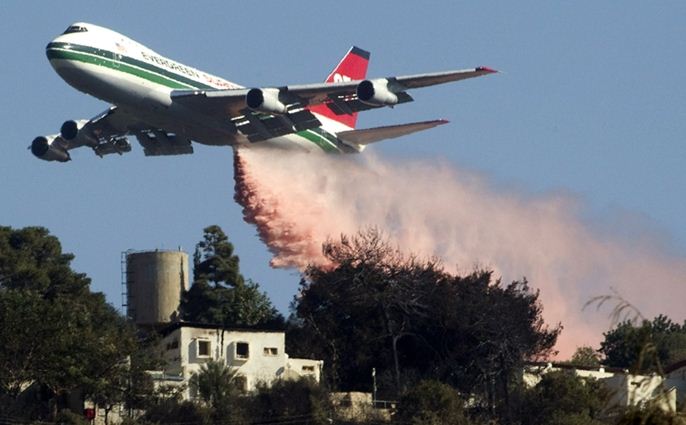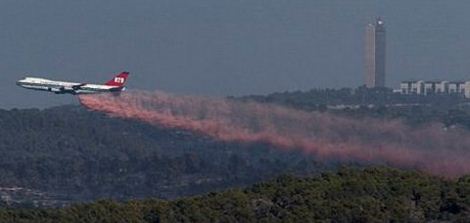
The word “control” is being used in Israel in describing the state of the fires that have killed over 40 people and blackened at least 9,000 acres. Fire official Boaz Rakia told reporters Sunday evening: “The fire department has declared that the fire is under control.” He added that the small fires are still burning in some places. Earlier on Sunday the Police announced that all of the major fires in the northern part of Israel were contained at 4:30 p.m., 77 hours after the largest fire started on Thursday.
Police also said there have been 20 attempts at wildfire arson over the previous 48 hours and four people have been arrested.
The United States’ National Interagency Fire Center has three Type 1 crews and some overhead sitting in Boise. They were going to depart on a military aircraft Sunday at noon but are being held “pending reassessment of situation on Monday”, according to a Tweet from @BLMNIFC at 9:03 a.m. Sunday. Other fire resources that were being mobilized out of the Northwest and Northern regions were canceled Saturday night and Sunday morning. Custer’s National Incident Management Team is already in Israel and should be operational on Sunday.
The 30+ firefighting aircraft that have swarmed into Israel to help suppress the fires will be held until Monday. Six U.S. Air National Guard MAFFS air tankers were scheduled to depart, I believe, Sunday morning for Israel, but it appears from the reports coming out of that country that they will not be needed.

Evergreen’s 747 Supertanker, Air Tanker 979, arrived in Israel Saturday evening local time and completed two sorties on Sunday. Below are some quotes from the Jerusalem Post about the aircraft:
“This aircraft was designed for the type of mega fires like the one that was here a few days ago,” said Steven Daniels, an Evergreen official who accompanied the plane on its maiden voyage to Israel. The plane has only been to one other country – Spain – outside of the United States in its four years of operations.
Daniels added that based on the aircraft’s previous experience combatting massive forest fires it would have been capable of extinguishing the Carmel inferno earlier had it arrived in time.
“Based on previous experience we could have stopped it,” he said.
[…]
The Israeli government contacted the Evergreen company late Friday and within 12 hours it was already en-route to Israel. “The plane was in Arizona and the pilot and rest of the crew were scattered,” Daniel said. “But we were excited to get the mission and to be able to help out Israel.”
Some reports have indicated that the government only learned of the plane’s existence from a random search on the internet. One Israeli Fire Service source said however that the plane’s existence was well known to firefighters but that they never imagined the government would pay the high fee to bring it here. According to some reports, it costs between $100-200 thousand dollars per hour of operations.
Captain of the plane, Cliff Hale, said that it was an honor to be in Israel. He has flown the plane in Alaska, southern California and in Spain.
“What makes our plane different is that its pressurized systems allow it to fly higher and faster,” he said. “This way we can get to scenes of fire faster.”
By Sunday afternoon, even though it was clear that the fire was mostly out, the plane’s crew said they intended to stay as long as they were asked.
“We are an insurance policy if the fire flares up again,” one of the crew members said.

Prime Minister Benjamin Netanyahu, calling the fire a “mega fire”, said he plans to set up a new squadron of firefighting aircraft. A screen grab (above) from the video below shows the Prime Minister speaking to reporters, while in the background you can see a video of the 747 Supertanker apparently undergoing drop tests a few years ago. A video very similar to the one behind Netanyahu can be found HERE.
The U.S. State Department made a way over the top video showing what appears to be Class A foam concentrate being unloaded from a U.S. C-130 in Israel. U.S. Ambassador James B. Cunningham interrupted the unloading so that he could stand in front of the cargo and make a speech at a microphone.

Airtankers are one of several tools we use. They will help slow or contain a fire to some extent but to be effective they need to work with ground units to get in a good fire line.
I have worked with many aviation contractors over the years and more then once a pilot has commented that dropping water is not working under some conditions
and why waste money and place resources at risk.
Wow,$100-200K per hour for Tanker 979. Wow(1959)$210 per hour for a TBM! If an incident commander can keep a fire from going into the second burning period (contained) the use of VLAT during extended attack is certainly justifiable. Example, Twichell Canyon Fire (Utah)last accounting $18 million. Another good example was the Station Fire. VLAT’s are just an airplane, maybe the right aircraft for the job (maybe not). The idea is to protect lives and property and keep the cost of suppression (management) from braking the backs of the taxpayer.
Don’t believe everything you read on the Internet, especially when it starts with “some reports”. The contract CalFire had with Evergreen in 2009 for the 747 called for them to pay $29,500 an hour plus the cost of fuel. However, if an agency only contracts for one incident, the cost would probably be higher. And then there’s the cost of about 20 hours of ferrying time to and from Israel. I expect that Israel paid at least 3/4 of a million dollars for the two sorties over their fire by the 747.
More info about CalFire’s contract with the 747 here:
https://wildfiretoday.com/2009/07/10/747-air-tanker-signs-with-calfire/
Bill, How much would that fire have cost if you folks from CalFire fought it, somewhere in the 20-30 million range because you would not have put it out for over a month! CalFire refuses to use it as an initial attack aircraft because it is too effective. Search LA Times on what a wild fire costs per day and what contractors get for such things as laundry trailers, sleeping trailers, bull dozers, etc,. Would these companies prefer these fires to be extinguished in one-day by a tanker costing eve one million, or would they prefer they go on for days or months!
(sigh)
Lonnie,
1. Air tankers don’t put out fires. Under some conditions they can slow the spread, but firefighters on the ground put them out. Aircraft can be very useful, but are one of many tools that a firefighter can use. In many situations and weather conditions, they are either ineffective or can’t be used at all. Strong winds, the condition that is most responsible for extreme fire behavior and rapid rates of spread, grounds air tankers. There were many days during the recent fire siege in Texas when all air tankers were grounded by strong winds, but the fires kept moving… rapidly. And a moderate wind, in which an air tanker CAN fly, may blow the retardant far away from the target, making the air tanker ineffective.
2. I don’t, and never have, worked for CalFire. But I have worked along side them often and am convinced that they have more experience and skill in fighting large vegetation fires than the fire organizations in Israel.
3. When the 747 made its first drop in Israel, the fire was virtually out already and had been declared controlled. Sometimes that’s called a “CNN drop”. Check out the photos.
4. Show me evidence that CalFire does not use the 747 for initial attack “because it is too effective”.
5. Contractors do not make strategy and tactics decisions on fires, or determine how quickly fires are suppressed.
6. Have a nice day.
There is a fire fighting kit available for the Lockheed C-130 Hercules. As best I know, it doesn’t take that long for it to be fitted and removed. If I am right on that and the Israeli Air Force did not have this equipment, there are serious questions to be asked as to why ?
http://upload.wikimedia.org/wikipedia/commons/1/15/MAFFS_loading_into_a_C-130_080623-F-7564C-071.JPG